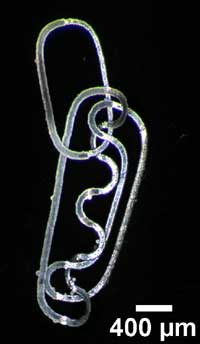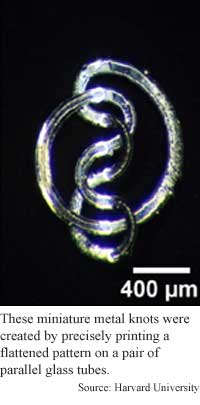
3-D geometry adds twists to microfabrication
By Ted Smalley Bowen, Technology Research NewsConstructing objects measured in microns or smaller could expand from a mostly two-dimensional pursuit to one benefiting from an extensive palette of complex, three-dimensional shapes.
Researchers at Harvard and McGill universities have combined a fabrication process that uses glass cylinders with design methods grounded in computational geometry to produce intricate knots made from pieces of metal narrower than a human hair.
The knots are constructed of complex shapes with smooth curves -- a feat difficult at such a small scale. “We don’t have in mind that people somehow need to make knots, but we want to emphasize the point that it is possible to make objects with complex topologies with three dimensional methods,” said Sue Whitesides, a computer science professor at McGill University.
The research could lead to quick prototyping and construction of three-dimensional objects such as springs, electromagnets, stents, and antennae out of metal parts, according to Whitesides. The smallest shapes the researchers have made to date measure about 1 millimeter across and are made of pieces of metal 70 microns wide by 20 microns thick. In contrast, human hair is about 75 microns in diameter.
Photolithography is the method of choice for creating very small two-dimensional structures, and variations of this technology have been used to construct simple, three-dimensional microstructures.
The researchers' soft lithography method produces more complicated three-dimensional shapes because it employs side-by-side glass tubes as forms. The method calls for breaking down a desired object into its constituent parts and printing tiny metal patterns for the parts onto the outside surfaces of the tubes. The metal that makes up the bulk of the shapes is electrically applied to the patterns, then the tiny parts are electrically welded together. The glass is dissolved in acid, leaving a complete metal shape.
The keys to the technology are the cylinders, which permit intersecting lines of a shape to cross without touching, and a computational geometry design algorithm, which generates the flat patterns that produce the three-dimensional shapes.
Whitesides applied the computational geometry methods to the fabrication process. “What I had noticed is that you can make any knot with their two-cylinder method, because there’s a way to essentially make one piece of wire cross over another,” Whitesides said.
The researchers were able to create trefoil, figure eight, and cinquefoil knots, a chain with complex links, Borromean rings, a Mobius strip, and a torus.
Although the two-cylinder method allows for any type of crossover, it does not provide full control over distances and angles within the shapes. The researchers noted that it is possible to more finely control these by using more than two cylinders, using cylinders in combination with planes, or distorting the cylinders.
The researchers’ ability to control materials at this small scale is an advance, according to Karl Bohringer, an associate professor in the department of electrical engineering at the University of Washington.
“These techniques have been around for quite a while. The novelty lies in the precision alignment between different metal [shapes],” said Bohringer. In addition, the technique should allow for fabrication of shapes much smaller than those they have made so far. "I believe that with a substantial effort this can be pushed well into the submicron range," he said.
The research could lead to the production of small-scale machine parts."This technique provides a great wealth of 3D structural capability to micro-robots," said Ron Fearing, an electrical engineering professor at the University of California at Berkeley.
It may be difficult to make these types of devices in large quantities, however, said Bohringer. "I don’t believe that this technique scales well. It will be difficult to batch fabricate larger substrates with large numbers of devices, which is the key to the success of conventional microfabrication.”
The design techniques could eventually be used with different fabrication methods to construct the same type of three-dimensional objects at the molecular level, Whitesides said.
"One could try this at a much smaller scale, [for example,] making DNA knots. One wouldn't be working with tiny glass cylinders, but one would be trying to take an object, break it into pieces and glue the pieces together... to make things that have complex topologies"
Whitesides’ research colleagues are Hongkai Wu, Scott Brittain, Janelle Anderson, Bartosz Grzybowski and George M. Whitesides, all from Harvard University. They published the research in the December 5, 2000 issue of the Journal of the American Chemical Society.
The work was funded by the Defense Advanced Research Projects Agency (DARPA), the National Science Foundation (NSF) and Canadian government operating grants.
Timeline: Unknown
Funding: Government
TRN Categories: Materials; Computer Science
Story Type: News
Related Elements: Photo 1, Photo 2; Technical paper, "Fabrication of Topologically Complex Three-Dimensional Microstructures: Metallic Microknots," Journal of the American Chemical Society, December 5, 2000
Advertisements:
December 20/27, 2000
Page One
Tiny wires store more
Tinier transistors keep Moore's Law on track
3-D geometry adds twists to microfabrication
Virtual annotation fosters understanding
Silicon process produces pockets


News:
Research News Roundup
Research Watch blog
Features:
View from the High Ground Q&A
How It Works
RSS Feeds:
News
Ad links:
Buy an ad link
| Advertisements:
|
 |
Ad links: Clear History
Buy an ad link
|
TRN
Newswire and Headline Feeds for Web sites
|
© Copyright Technology Research News, LLC 2000-2006. All rights reserved.